Home » Blog » Common Checkout Abandonment Causes & Solutions to Reduce Them
Common Checkout Abandonment Causes & Solutions to Reduce Them

Checkout Abandonment Vs Cart Abandonment

Both of these seem alike, but they are not.
Cart Abandonment occur when a user exits the website or app without purchasing after adding a product or service to a cart.
On the other hand, Checkout Abandonment happens when a user doesn’t complete the transaction after initiating checkout.
So, let’s say you run a Bakery Shop. Cart abandonment is when someone adds products to purchase, but rather than buying, they exit the shop.
And Checkout abandonment happens when they somehow can’t complete the transaction at the cash counter.
1. Charging unexpected extra cost for shipping, taxes, or fees
One big reasons for checkout abandonment is when visitors encounter additional shipping costs, taxes, or fees on the checkout page.
Try to think from the customer’s POV. They are on the product page; they look at the price (pricing is an essential factor that drives sales) and decide to buy it.
But when they reach to the checkout page and looked at the total price, there are additional charges which they were not communicated earlier, like shipping cost, tax charges, etc.
Not only does it cause a bad buying experience, but it also hurts the brand’s image. As customer’s expect that you be transparent to them.
Actionable solutions to counter it;
- Showcase pricing & other additional charges clearly on the product and cart pages.
- Display how much they will have to pay at every touchpoint where they make a buying decision.
- If there are custom pricing option, help them to easily navigate to you.
- If you are shipping internationally, communicate additional charges and other tax related information upfront.
2. Mandatory account creation
Suppose you visit a store for the first time and decide to buy something, but the shop owner asks you to register your email or mobile number before making a purchase – wouldn’t it drive you crazy?
Apply the situation to those customers who are first time visitor and just want to make a purchase. Or it might be that what you are selling is something that they only wants it once, in both the cases they don’t want to create a account.
Though you might say that it builds your email or contact list, which undoubtedly it does, however, look at it from their perspective – they first need to trust (and experience) you before creating an account.
Also, if you force them to create an account first, they might enter the wrong details.
Moreover, requiring to create an account complicates their purchase journey, making the buying process longer.
Solutions;
- Give them the option to buy as a Guest, where they don’t have to create an account to purchase.
- Post-purchase, send them a personalized Email or SMS and mention the benefits of creating the account. It could be promo codes, season discounts, etc. But don’t SPAM them. Just one message to convey the advantage of creating an account.
- Offer discounts or incentives to sign up during the checkout process.
3. Not happy with your delivery service
Logistics is an integral part of your E-commerce strategy. It directly impacts your customer’s purchase decision, which impact your E-commerce’s bottomline.
It includes how fast you deliver, whether your delivery without causing any damage, whether you offer inclusive delivery options, etc. Many companies online have build USPs on this.
Also, how you delivery depends on your industry.
Let’s say if you are in the food and beverages industry; it’s expected that you deliver fast. Or if you sell easy-to-damage goods, convey how you are ensuring that there are no damages.
Solutions;
- Mention expected delivery time and charges upfront.
- Partner with good delivery partners.
- Give the option on your product page to show the delivery charges at set pin code/zip code.
- Offer express or fast delivery options.
- Offer free shipping at a certain amount.
- Offer free shipping for the first purchase.
- Offer customers the feature to track their orders.
4. Long or complicated checkout process
You don’t want your customers to get tangled in the complexity of making the purchase, too, at the stage where they are making the transaction.
Aim to make your checkout process smooth and seamless, making them take as few decisions as possible.
Some examples of making the process complicated are creating an account before purchasing or asking for too much unnecessary information.
Some tips to make your checkout process smooth:
- Looking to remove any unnecessary steps. Trim it down.
- Given the option to make Guest purchase.
- Utilize the auto fillers feature to place the text in fields. Like giving address suggestions.
- Don’t take the shipping address or other details if you offer digital goods.
- Provide a click purchase option.
5. Errors or crashes during the checkout process
Too many crashes make the overall buying experience bad and push the buyers to either hold the purchase or buy from your competitor. What is worse is that it also impacts their ability to trust you again because negative experience has a bigger and powerful impact on humans than positive one.
It also reduced the NPV score.
Though you can not perfect it in one go, you can invest time and resources to monitor it to ensure it only sometimes happens.
Also, if your buyers are from remote areas or places with too many network issues, you can think of strategies like offering a Lite website/app or an option to make purchases through SMS or WhatsApp.
Solution to reduce it;
- Have a plan of action to resolve those customers’ queries whose money got credited and the transaction failed.
- Never compromise on your website’s hosting.
- Have a strategy to deal with upcoming potential traffic inflow.
- Perform routine website and app maintenance checkups to resolve any potential issues that will occur.
6. Preferred payment method is not available
It’s human tendency to always look for convenience and familiarity wherever we go – and similarly, your customers are also looking for preferred payment methods to make a purchase more than anything.
And it’s also powerful, because everyone are very peculiar when it comes to finance. And if you are not providing them, they will drop and move to look at your competitor.
What you can do;
- Provide them various payment methods like debit cards, credit cards, net banking, UPI, Paypal, Stripe, etc.
- Offer them the ease to finance the purchase. It is primarily important if you are selling high-ticket products.
- Understand your target audience’s payment preferences based on their location (geographical segmentation) and buying behavior.
- Give the option of COD to customers. But don’t forgot to add COD verification.
- Have a plan for resolving any finance-related query, like transaction failure, etc.
7. Not responsive for Major Devices
Around 63% of online shopping orders are generated through mobile devices – and not making your checkout page responsive will hurt your bottom line.
What you can do:
- Make your website’s checkout page responsive for common devices, like mobile, desktop, and tablet.
- Eliminate unnecessary features for mobile or tablet.
- Instil features that are specific for mobile or tablet users. Like providing WhatsApp option.
8. The checkout process doesn’t seem secure for payment
What you can do about it;
- Mention what security measures you are taking to make their page more secure.
- Showcase payment security certifications; this makes them confident to make the purchase.
- Provide easy to navigate to your website’s privacy policy.
- Integrate with trusted payment gateways. Like Razorpay, Paytm, or Paypal.
How to calculate Checkout Abandonment Rate
You can set up a Checkout abonnement rate in Google Analytics or using tools like Monsterinsights.
To calculate it, use the formula mentioned below:
Checkout Abandonment Rate = 1 – (Number of transactions or orders completed /Number of checkout initiated) X 100
Now that you have calculated, you might wonder what a reasonable checkout rate for your business or industry is.
So, there is no particular set answer, though it depends from industry to industry.
What I’ll suggest you is to compare it with your past performances and keep on trying to improve your checkout experience.




